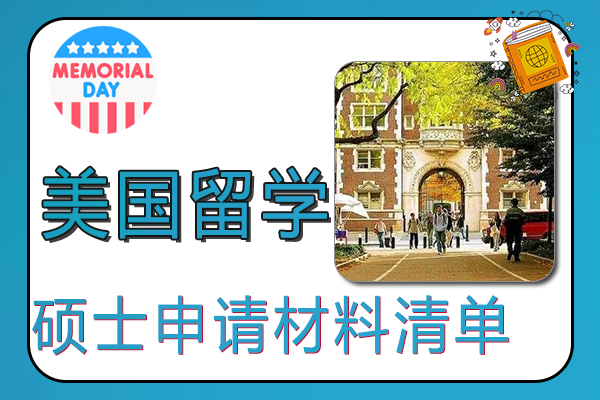Although there are many countries to study in, most people still have the United States as their main goal. The following is a list of information aboutMaster's degree application materials list for studying in the United StatesMaterials for studying in the United States, ,Study in the United States visa materials, ,Review of study materials in the United States, ,Preparation Materials for Studying Abroad in the U.S. in SpringThe problem.

Master's Degree Application Materials List
Master's Degree Application Materials List
1. Online Application (Application Form)
The vast majority of American universities require applicants to fill out an application form online and submit it online before the deadline.
2. (Undergraduate/Graduate transcript)
For every American university, transcripts are essential application materials. Official transcripts must be issued by the student's original school and then mailed to the school to which they are applying.
If you are a senior student, you will need to provide all the grades for the previous three years.
If you are a student who has already graduated from college, all your grades for four years of college are required.
If you are a graduate student, you need your graduate grades and all your grades for four years of undergraduate study.
The transcript must have the official seal of the Academic Affairs Office, and the envelope must be sealed by the Academic Affairs Office and stamped on the seal. It must be in both Chinese and English. It is worth noting that many admissions offices of American schools now only accept transcripts certified by WES. Therefore, before applying, applicants must send an email/call to ask clearly whether the school they are applying to requires students to have their transcripts certified.
3. Certificate of Schooling
The enrollment certificate is a formal letter issued by the school to students who have not yet received their degree certificates, used to prove that a student is enrolled in a certain major in the school. The enrollment certificate must have the official seal of the school's Academic Affairs Office, and the Academic Affairs Office must seal the envelope and stamp the seal, and it must be an original document in both Chinese and English.
4. Diploma & Certificate of Degree
Applicants who have graduated from university need to provide a graduation certificate and degree certificate. The requirements are the same as for the proof of enrollment. It must have the official seal of the Academic Affairs Office and be sealed in an envelope with a seal on the seal. It must be an original document in both Chinese and English.
5. TOEFL Official Score (language score)
Language scores are crucial materials in the application process, especially for Chinese students who are eager to study abroad. All American schools have clearly stated that they only accept official scores from ETS. Therefore, applicants must "send scores" (order official score reports) when applying.
Of course, if you have studied in the United States for four years and obtained a bachelor's degree, you can waive the TOEFL test. American colleges still have great advantages! But if you have studied in a four-year university in China, then the TOEFL test is a must.
For example, the graduate admission requirements for English proficiency at Columbia University's Teachers College are as follows:
6. GRE/GMAT Official Score
When applying for graduate school in the United States, GRE/GMAT (some majors may also require GRE SUB scores) are required, and the school clearly states that only official scores from ETS are accepted. Therefore, applicants must "submit scores" when applying.
7. Personal Statement
Schools require applicants to write a self-declaration essay, and some schools call it a Statement of Purpose. Although the names are different, there is only one purpose, that is, you must use this article to let the admissions officer know that you are an excellent and suitable candidate.
8. Recommendation Letters (Three)
Generally speaking, graduate schools in the United States require three letters of recommendation. The recommender should be very familiar with the student and have a certain degree of fame. He should be a professor or advisor who has taught you. If you have graduated for many years, you can also ask your supervisor at work to write for you. The current application system only requires applicants to fill in basic information such as the applicant's name, email address, phone number, etc. online, and then send a request. The recommender will receive an email and fill in the online recommendation letter.
9. Curriculum Vitae/Resume
The Curriculum Vitae is slightly longer, and can be written in 2-5 pages. The Resume is generally shorter, and is 1-2 pages. The basic content must include: personal information (name, address, contact number, email address), academic background (research direction, undergraduate and graduate school/major/GPA, etc.), certificates, published articles, professional skills, honors and awards, research experience, work experience, academic interests, social/volunteer activities, etc.
10. Bank Statement (Property Certificate)
The funds are the sum of the first year's tuition and living expenses (the school will mark this)
US version: Generally, the bank will issue a certificate indicating how much money is in the account as of that day. There is no expiration date because the US does not require freezing. It is generally valid for three months (for example, a certificate issued on 01/01/2017 will be generally recognized by US universities before 04/01/2017).
Chinese version: Generally needs to be frozen, the recommended freezing period is 3-6 months, and an English translation is required.
11. Others
Some majors require submission of Writing Sample
Some majors require submission of a Research Proposal
Some majors require submission of additional essays
Some majors require submission of a portfolio
If your overall GPA is average but your class ranking is excellent, you can get a ranking certificate from the department.
Further reading: Introduction to US study visa types
Type 1: F visa
This type of U.S. student visa is for international students who intend to pursue an academic degree at an accredited U.S. college or university, or to study English at a university or institution that provides English language enhancement. There are three types of F visas:
▪F-1 visa is for full-time students
▪The F-2 visa is for the dependents (spouse and unmarried children under the age of 21) of an F-1 visa holder, including spouses of the same sex.
▪The F-3 visa is for "border commuters" - students who live in Mexico and Canada in their country of origin, but attend school in the United States part-time or full-time.
Students with an F-1 visa may work on campus for 20 hours or less per week. Students who wish to work longer hours and work off-campus must obtain prior approval from the United States Citizenship and Immigration Services (USCIS) - they may also be authorized to work for Curricular Practical Training (CPT) and Optional Practical Training (OPT) for a full 12-month period, excluding the 90 days of unemployment.
Type 2: M visa
This type of US student visa is for international students who want to participate in non-academic, vocational studies or obtain training at an institution in the United States. There are three types of M visas:
▪M-1 visa is for students who are going to study vocational or non-academic courses
▪M-2 visa is for family members of M-1 visa holders (same as F-2 visa)
▪The M-3 visa is for "border commuters" and, like the F-3 visa, is for vocational or non-academic study.
Students on an M-1 visa are admitted to the U.S. for a fixed period of time - the length of their training program plus any optional practical training. They cannot stay in the U.S. for more than one year, except for medical extensions. M-1 visa holders are not allowed to work on or off campus during their studies, and cannot change status to an F-1 visa.
The third type: J visa
This last type of US student visa is for international exchange visitors who are participating in a US program to promote cultural exchange. Regardless of whether they are receiving medical, business, or other training, all applicants must meet the eligibility criteria for the program in question and be sponsored by a private sector or government program. J visa holders usually stay in the US for only a short period of time, perhaps 1 or 2 semesters. There are two types of J visas:
▪J-1 visa is for exchange students in related exchange programs
▪J-2 visa is for family members of J-1 visa holders (same as F-2 visa)
J-1 visa holders who are part of a government-sponsored exchange program will be subject to a two-year return-to-country residency requirement to pursue graduate medical education, training, or training that is included on the exchange visitor skills list (i.e., the J-1 visa holder's country of origin deems their expertise or skills necessary for the country's development). These requirements mean that J-1 visa holders will need to return to their country of origin at least two years after completing their exchange visitor program.
Further reading: Budget table for self-funded study in the United States
1. Tuition fees
For high school studies, the school fees are not cheap. If it is an ordinary high school, you need to prepare 280,000 to 560,000 yuan a year. The fees for high schools that provide accommodation will be more expensive because they provide more services, about 400,000 to 600,000 yuan a year.
The cost of undergraduate study is mainly affected by the nature of the school. If you attend a public university, you need to prepare 250,000 to 350,000 yuan a year; if you attend a private university, you need to prepare 300,000 to 500,000 yuan a year; if you attend a liberal arts college, you need to prepare 300,000 to 500,000 yuan a year; if you attend a community college, you need to prepare 100,000 to 200,000 yuan a year.
The tuition fees for postgraduate courses vary mainly by major. Liberal arts and business majors cost 500,000 to 700,000 yuan a year, while science and engineering majors only cost 300,000 to 500,000 yuan. At the doctoral level, students can basically get full scholarships, and most students even receive living allowances.
2. Living Expenses
1. Food and Beverage
The school has a cafeteria, and a meal costs about 30-50 yuan. The advantages are that it is convenient, safe and fast. If you want to improve the food, you can eat out or cook it yourself. The latter requires cooking skills, and the total cost is about 3,000-5,000 yuan a month.
2. Accommodation
You can choose to live on campus, rent a house or board. Dormitories will provide safe and fast services and the cost will be cheaper. Renting a house will give you more freedom in your living space and the price will be more expensive. If you board, you will have someone to supervise you. The average cost is 4,000-6,000 yuan per month.
3. Travel
No matter which city you study abroad in, you basically have to travel by car. Because the distances are not close, you need to take the bus or subway. Choose the method that suits you. The monthly expenses are calculated based on the frequency and are between 700-1500 yuan.
4. Insurance
Don't forget to buy medical insurance. The cost of seeing a doctor in the United States is relatively high. Fortunately, comprehensive medical insurance is popularized. As long as you join the medical insurance system, you can get reimbursement. The basic program costs about 5,000 yuan a year.
5. Others
Of course, everyone also needs to buy things and socialize, so there will be more flexibility, depending on everyone's own expenses. This part will directly affect everyone's life. It is recommended to make a budget first and prepare at least 2,000 yuan a month.
Further reading: Application process for studying in the United States
1. Take the exam
The first thing to start is English preparation, because when you go to study in the United States, you need to provide transcripts of qualified language standardized tests. Whether it is IELTS or TOEFL, you need to receive training in advance to familiarize and adapt to the model and content.
The recognition of both types of exams is very high, so you can just choose one type for intensive study. Basically, there are exams scheduled every week, so when you are preparing, you can agree on the exam time in advance to ensure that you can get the test results within the specified time.
2. Confirm your goals
You need to learn about the schools and majors you are applying for in advance, so you need to spend time screening, which is generally not very time-consuming. Because at least one of them will have a clear goal, and then you can conduct a comprehensive assessment based on planning, ability and ranking.
3. Prepare Materials
In the formal material preparation, you need to accumulate and prepare the hardware in advance, so when the time comes, you can directly obtain it. The academic certificate and GPA transcript, as well as the language test certificate, can be obtained directly after the date.
The statements and awards in the document preparation must be prepared according to the requirements, and fully demonstrate your true situation and explain your future study and employment plans. These are relatively complicated contents, and everyone must do them wholeheartedly.
Recommendation letters should also be taken very seriously, especially those written by people who need to be confirmed to be of relatively high status; other materials that prove one's ability, such as award certificates, internship certificates, published articles, etc., will all have a relatively positive effect and can increase the admission rate.
IV. Submit your application
Submit your application early to leave yourself enough time, and you will also get the final review results earlier. You don’t need to worry about missing the time. Because some majors are more popular, the channel will be closed when the number of students is full, so it is better to submit early.
The waiting time for review is about two months. During this period, you can keep in touch with the school to confirm the status of your material review to ensure that it goes smoothly. After receiving a satisfactory offer, you can directly confirm the admission.
Master's Degree Application Materials List
Summary of the application materials list for a master's degree in the United States
After understanding the issues regarding the list of application materials for a master's degree in the United States, you will also need to prepare an Internet tool to bypass the firewall and return to China when studying in the United States.For many Chinese who go to the US to study and work, they still like to watch some Chinese TV series and programs in China, and they are more accustomed to use some domestic native apps to listen to music, watch videos, play games and so on. However, due to copyright reasons, most of the popular programs are only allowed to be accessed by mainland IPs. In such a big background, theBack to China via the InternetQuickFox is a VPN that allows you to access the Chinese network at high speed. With QuickFox, you can watch Chinese videos, live broadcasts, listen to Chinese copyrighted music, and even play Chinese games.














